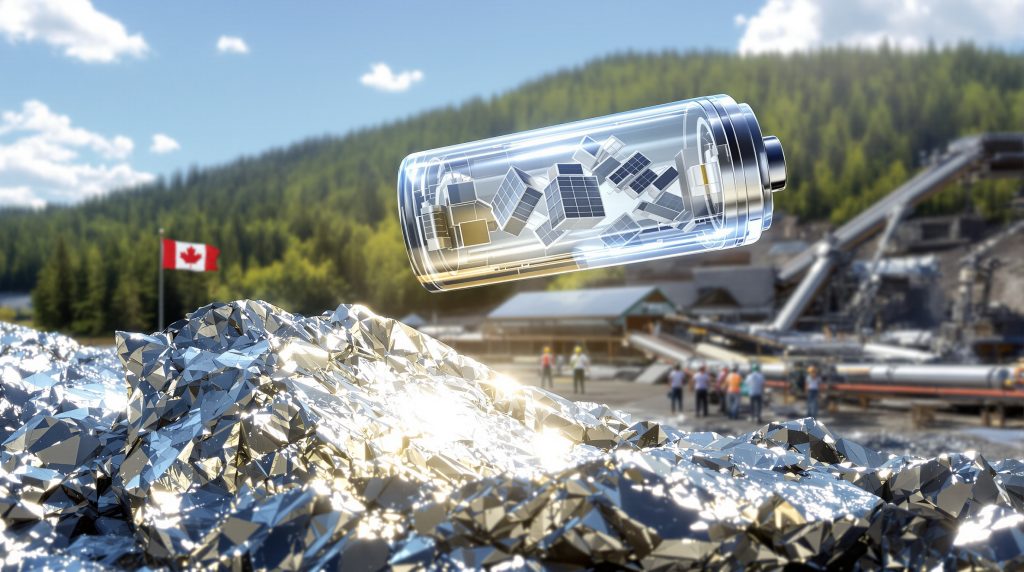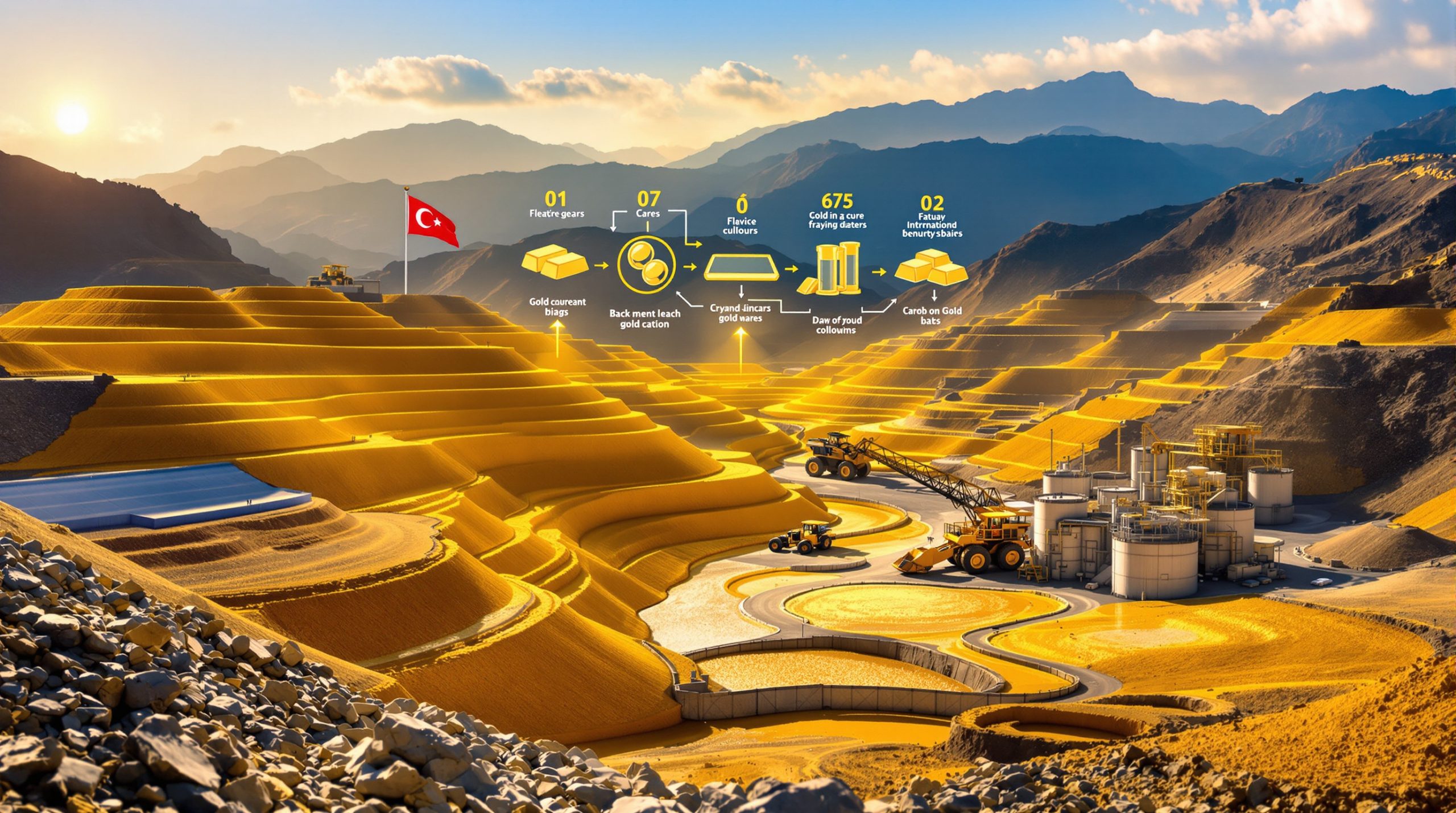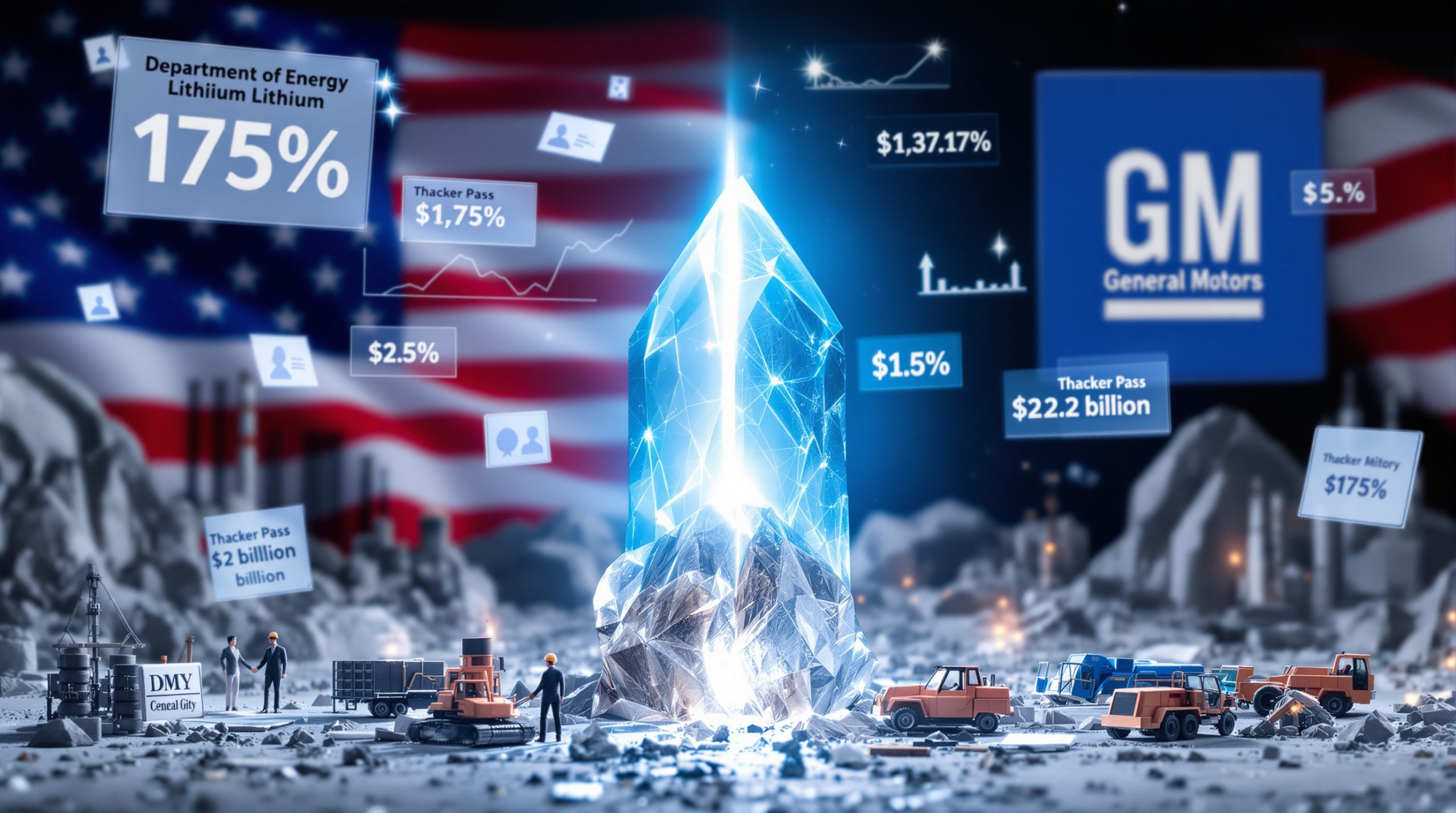What is the Phase-2 Matawinie Mine Project?
The Phase-2 Matawinie Mine represents a significant advancement in North American graphite production, strategically positioned to meet the growing demands of electric vehicle and energy storage markets. Located in Quebec, Canada, this project is being developed by Nouveau Monde Graphite (NMG) as part of their vision to create a fully integrated battery materials supply chain on North American soil. The project aims to establish a secure, local source of high-quality graphite at a time when supply chain resilience has become increasingly crucial.
The mine's development comes at a pivotal moment when North America is actively seeking to reduce dependence on overseas materials, particularly for critical battery components. With graphite being the largest component by weight in lithium-ion batteries, securing domestic supply has become a strategic priority for both governments and manufacturers.
Eric Desaulniers, NMG founder, president and CEO, emphasized this strategic importance: "Resource nationalism, tariffs, policy headwinds and shifting global alliances are creating uncertainty in global supply chains and investment planning. Nevertheless, we remain centred on our mission to develop a responsible and resilient North American graphite value chain for the battery sector to help meet the expansion of the electric vehicle and energy storage markets."
Key Components of the Matawinie Project
The Phase-2 Matawinie Mine features several interconnected components designed to create a comprehensive graphite production ecosystem:
-
State-of-the-art Extraction Facilities: The mine incorporates advanced graphite extraction technologies designed specifically to minimize environmental impact while maximizing resource recovery
-
Processing Infrastructure: Purpose-built facilities will transform raw graphite ore into high-quality flake graphite suitable for battery applications
-
Environmental Management Systems: Comprehensive water management, tailings storage, and mine reclamation innovation plans have been integrated from the project's inception
-
Vertical Integration Strategy: The mine functions as the upstream component of NMG's broader strategy, connecting directly to their Bécancour Battery Material Plant for downstream processing
-
Renewable Energy Integration: The project incorporates clean energy sources to reduce carbon footprint throughout the production process
This comprehensive approach positions the Phase-2 Matawinie Mine as more than just a mining operation—it represents a crucial link in developing a complete North American battery materials ecosystem.
How Far Has the Project Progressed?
The Phase-2 Matawinie Mine is currently in an advanced pre-construction phase, with significant progress being made toward a final investment decision (FID). The project team is simultaneously advancing multiple workstreams to ensure all necessary components are in place before construction begins.
The mine has already completed several critical development milestones, including environmental assessments, community consultations, and preliminary engineering designs. Current efforts focus on finalizing the technical and financial elements needed to proceed with full-scale development.
The advancement of the project has maintained steady momentum despite global supply chain challenges and shifting market conditions, demonstrating the team's ability to navigate complex development environments.
Current Development Activities
Several parallel activities are currently underway at the Matawinie site:
-
Detailed Engineering Work: Engineering teams are finalizing technical specifications, equipment selections, and facility designs to ensure optimal operational performance
-
Supplier Negotiations: The project team is engaging with potential service providers and equipment suppliers to secure necessary components and services
-
Construction Planning: Comprehensive bid packages are being developed for major construction elements, allowing for rapid mobilization once FID is achieved
-
Environmental Infrastructure Development: Key environmental management systems are being constructed at the demonstration site to validate designs and establish baseline operations
-
Production Capacity Enhancement: Capabilities at the demonstration mining location are being expanded to support research, testing, and optimization activities
These development activities are being carefully coordinated with ongoing financing efforts to ensure seamless transition into full construction phase when the final investment decision is reached. The parallel workstreams approach allows the project to maintain flexibility while advancing toward commercial operation.
What's Happening at the Bécancour Battery Material Plant?
The Bécancour Battery Material Plant represents the critical downstream component of NMG's integrated graphite strategy. Located in Quebec, this facility is designed to transform raw graphite from the Matawinie Mine into advanced battery-grade materials essential for EV mining transformation and energy storage applications.
The plant will enable NMG to capture significantly more value from their graphite resources by producing specialized battery anode materials rather than simply exporting raw graphite. This vertical integration strategy aligns with broader North American efforts to develop complete battery supply chains domestically.
Development of the Bécancour facility is progressing on multiple fronts, with technical and commercial activities advancing in parallel with the mine development.
Current Progress at Bécancour
Key developments at the Bécancour Battery Material Plant include:
-
Advanced Engineering Work: Intensive design and engineering activities are underway with specialized technical support to optimize processing configurations
-
Strategic Asian Partnerships: Collaboration with experienced Asian technical partners is providing valuable expertise in battery material processing technologies and quality control methodologies
-
Comprehensive Testing Programs: Planning is underway for large-scale validation testing at partner facilities to confirm production parameters and material performance
-
Process Technology Refinement: Technical teams are fine-tuning processing methodologies to ensure optimal material quality, efficiency, and environmental performance
-
Market Entry Strategy: Commercial teams are developing detailed plans for product qualification, customer engagement, and market penetration
These efforts are crucial for confirming technical parameters and informing the final investment decision process. The integration of mining and processing operations provides NMG with unique advantages in quality control, supply chain management, and production optimization.
How is NMG Securing Project Financing?
Financing represents one of the most critical elements in advancing the Phase-2 Matawinie Mine toward construction. NMG is implementing a sophisticated, multi-faceted approach to secure the necessary capital investment in a challenging global financial environment.
The project's strategic importance within the North American battery materials landscape has attracted significant interest from various financial stakeholders, including government agencies, institutional investors, and potential customers. This diverse interest provides multiple pathways to complete the financing package.
NMG's financing strategy balances debt and equity components while leveraging strategic partnerships to distribute risk and enhance project credibility.
Financing Strategy Elements
The company is pursuing several parallel financing tracks:
-
Customer Engagement: Active discussions with potential off-take partners in the battery and EV sectors to secure purchase commitments that can support project financing
-
Lender Outreach: Negotiations with various debt financing sources to structure appropriate lending packages with favorable terms
-
Strategic Equity Investments: Discussions with institutional investors seeking exposure to the growing battery materials sector through strategic equity positions
-
Bankable Offtake Agreements: Development of binding purchase commitments that can serve as collateral for project financing
-
Government Support Programs: Engagement with various government initiatives designed to support critical minerals transition
Current Financing Progress
NMG has made significant progress in securing potential financing sources. According to recent financial reports, the company has received letters of interest exceeding $1 billion (C$1.38 billion) in potential debt financing for the Phase-2 projects. This substantial interest demonstrates the financial market's recognition of the project's strategic importance and commercial potential.
The projected financing structure includes participation from a diverse group of sources:
-
Governmental Agencies: Public sector support acknowledging the strategic importance of domestic graphite production
-
Development Institutions: Lending organizations focused on infrastructure and economic development
-
Export Credit Agencies: Including Export Development Canada, which supports Canadian exports and international business development
-
Infrastructure Investment: Potential participation from Canada Infrastructure Bank to support critical infrastructure components
This multi-source approach provides resilience against individual financing challenges while maximizing available capital on favorable terms. The strong interest from diverse financing sources reflects confidence in both the project's fundamentals and NMG's management team.
Why is This Project Strategically Important?
The Phase-2 Matawinie Mine holds exceptional strategic significance within the North American battery materials landscape. Its importance extends beyond commercial considerations to encompass national security, economic development, and clean energy transition objectives.
As governments and manufacturers increasingly recognize the vulnerabilities in current battery material supply chains, projects like Matawinie that offer domestic alternatives have gained prominence. The mine represents a rare opportunity to establish a secure, transparent, and environmentally responsible graphite source in North America.
The timing of the project aligns with multiple favorable policy and market trends that enhance its strategic positioning.
Market Positioning Advantages
Several factors contribute to the project's strategic importance:
-
Resource Nationalism Trends: Governments worldwide are increasingly prioritizing domestic control of critical minerals, creating supportive policy environments for projects like Matawinie
-
Evolving Tariff Environment: Recent US Department of Commerce duties on Chinese graphite materials have improved the competitive position of North American producers
-
Supportive Policy Framework: Both US and Canadian governments have implemented policies supporting critical minerals development, including financial incentives and streamlined permitting
-
Supply Chain Vulnerabilities: Current battery material supply chains remain heavily concentrated in specific regions, creating risks that Matawinie helps mitigate
-
Accelerating EV Adoption: Rapidly expanding electric vehicle production is creating unprecedented demand for battery materials, with graphite being the largest component by weight
-
Energy Storage Growth: Beyond EVs, the expanding grid-scale energy storage sector requires substantial graphite supplies to support renewable energy integration
These factors combine to create a uniquely favorable environment for the Phase-2 Matawinie Mine, positioning it as a cornerstone of North American battery metals strategy.
What Challenges Does the Project Face?
Despite the favorable strategic positioning and progress to date, the Phase-2 Matawinie Mine faces several significant challenges that must be navigated to achieve successful development. These challenges span technical, financial, and operational domains, requiring careful management and mitigation strategies.
The project team is actively addressing these challenges through comprehensive planning, strategic partnerships, and flexible execution approaches. Their ability to navigate these complexities will significantly influence the project's ultimate success and timeline.
Key Project Challenges
The primary challenges facing the Phase-2 Matawinie Mine include:
-
Global Supply Chain Disruptions: Ongoing uncertainties in equipment and materials availability can impact construction schedules and costs
-
Financial Market Volatility: Changing investor sentiment toward mining and battery material projects affects capital availability and terms
-
Execution Timeline Coordination: Synchronizing multiple complex workstreams toward FID requires sophisticated project management
-
Technical Performance Optimization: Ensuring consistent, high-quality graphite production that meets stringent battery manufacturer specifications
-
Regulatory Compliance Requirements: Meeting comprehensive environmental, safety, and community engagement standards throughout development and operation
-
Market Qualification Timelines: Battery manufacturers typically require extensive testing and qualification periods before committing to new material sources
-
Workforce Development: Securing appropriately skilled personnel in a competitive labor market presents ongoing challenges
The project team has developed specific mitigation strategies for each of these challenges, incorporating flexibility, redundancy, and contingency planning to maintain momentum toward commercial operation. Their approach acknowledges the complexity of modern mining development while establishing realistic pathways to success.
How Does This Project Support Sustainability Goals?
The Phase-2 Matawinie Mine has integrated sustainability considerations throughout its design, setting new standards for responsible mining development. This approach aligns with broader industry trends toward environmental stewardship while supporting the transition to clean energy technologies.
By producing materials essential for electric vehicles and renewable energy storage, the project delivers a double sustainability benefit: responsible production practices combined with enabling technologies that reduce global carbon emissions. This dual impact positions Matawinie as a model for modern resource development.
The project's sustainability approach extends beyond environmental considerations to encompass social responsibility, economic development, and governance practices.
Sustainability Elements
Key sustainability features of the Phase-2 Matawinie Mine include:
-
Comprehensive Environmental Infrastructure: Purpose-built systems for water management, waste handling, and site rehabilitation minimize ecological impacts throughout the mine lifecycle
-
Transparent Supply Chain Development: Establishing fully traceable material sourcing with documented environmental and social performance
-
Transportation Efficiency: North American production significantly reduces transportation emissions compared to overseas imports that typically travel thousands of miles
-
Clean Energy Applications: Supporting electric vehicle and renewable energy storage markets that directly contribute to global carbon reduction goals
-
Local Economic Development: Creating sustainable jobs and economic opportunities in Quebec communities while developing technical expertise
-
Circular Economy Initiatives: Implementing waste reduction strategies and exploring potential reuse applications for mining byproducts
-
Community Engagement: Maintaining ongoing dialogue with local communities to ensure project benefits are broadly shared
These sustainability elements are not merely secondary considerations but core components of the project's design and operational philosophy. They reflect NMG's understanding that modern mining projects must deliver both commercial returns and broader societal benefits to succeed in today's environment.
What's the Timeline for Final Investment Decision?
While a specific date for the final investment decision has not been publicly announced, NMG is actively advancing all necessary workstreams to reach this critical milestone. The company is refining its execution plan to capitalize on favorable market conditions while addressing potential uncertainties.
The FID represents the pivotal moment when NMG will formally commit to full-scale construction of the Phase-2 Matawinie Mine, transitioning from development to implementation. This decision requires alignment of technical, financial, commercial, and regulatory elements to ensure project success.
The timing of FID will be influenced by multiple factors, including market conditions, financing arrangements, and technical readiness. NMG's approach emphasizes thorough preparation rather than arbitrary deadlines to maximize project value and minimize execution risks.
Pre-FID Activities Underway
Several critical activities are currently progressing toward enabling the final investment decision:
-
Engineering Package Completion: Finalizing detailed technical specifications and construction-ready engineering documents
-
Financing Package Assembly: Securing necessary debt and equity commitments from various sources to fund construction and commissioning
-
Offtake Agreement Finalization: Completing binding purchase contracts with battery manufacturers and other customers
-
Construction Readiness Planning: Developing detailed implementation plans for site preparation, infrastructure development, and facility construction
-
Strategic Partnership Establishment: Forming key relationships with technology providers, equipment suppliers, and service contractors
-
Regulatory Compliance Verification: Ensuring all permits and approvals are in place to allow immediate construction commencement
The convergence of these workstreams will determine the precise timing of FID. According to the company's updated feasibility study, NMG's management has emphasized that they are prioritizing comprehensive preparation over rushed execution to ensure long-term project success.
How Does This Project Fit Within the Global Graphite Market?
The Phase-2 Matawinie Mine represents a significant development within the evolving global graphite landscape, particularly as battery material demand accelerates. The project enters a market characterized by growing supply-demand imbalances, quality constraints, and geographic concentration risks.
Graphite demand for battery applications is projected to grow substantially over the coming decade, driven primarily by electric vehicle production and energy storage deployment. This growth is creating opportunities for new producers who can meet stringent quality requirements while offering supply chain advantages.
The project's positioning within North America provides unique advantages in serving regional battery manufacturers while reducing transportation costs and supply chain complexities.
Market Context
Key market factors influencing the Phase-2 Matawinie Mine include:
-
Accelerating Supply-Demand Gap: Battery material demand is growing faster than available supply, creating market opportunities for new producers
-
Geographic Diversification Imperative: Battery manufacturers are actively seeking to reduce dependency on highly concentrated production regions
-
Stringent Quality Requirements: Battery applications require consistent, high-purity graphite that meets precise specifications
-
Value Chain Integration Advantages: Connecting mining operations directly to processing capabilities enhances quality control and reduces intermediary costs
-
Strategic Timing: The project's development timeline aligns with projected acceleration in electric vehicle adoption curves
-
Processing Technology Differentiation: Advanced purification and processing capabilities enable production of specialized battery-grade materials that command premium pricing
-
Sustainability Premium: Environmentally responsible production increasingly commands market advantages as manufacturers focus on reducing supply chain carbon footprints
These market dynamics create a favorable environment for the Phase-2 Matawinie Mine, particularly as North American and European battery manufacturing capacity expands. The project's ability to provide a secure, transparent, and environmentally responsible graphite source addresses multiple market requirements simultaneously, making it an attractive investment opportunities 2025 consideration.
FAQ About the Phase-2 Matawinie Mine
What is the production capacity of the Phase-2 Matawinie Mine?
The Phase-2 Matawinie Mine is designed to produce high-quality battery-grade graphite materials to support North American electric vehicle and energy storage markets. While specific production volume targets continue to be refined through the detailed engineering process, the facility is scaled to represent a significant contribution to North American battery material supply chains.
Who is developing the Phase-2 Matawinie Mine?
The project is being developed by Nouveau Monde Graphite (NMG), a Canadian company focused on establishing a fully integrated source of carbon-neutral battery anode material in North America. NMG brings together mining expertise, processing technology, and sustainable development practices to create a comprehensive graphite production capability.
Where is the Phase-2 Matawinie Mine located?
The mine is located in Quebec, Canada, with the associated Bécancour Battery Material Plant also situated in Quebec. This creates an integrated provincial battery materials production chain that minimizes transportation requirements while leveraging Quebec's clean hydroelectric power and supportive mining policies.
What makes this project significant for North America?
This project represents an important step toward establishing domestic supply chains for critical battery materials in North America. It reduces dependency on overseas imports, creates regional jobs, shortens supply chains, and establishes more resilient battery material sourcing for electric vehicles and energy storage applications. The project aligns with broader government objectives to secure domestic supply of critical minerals.
How does the project address environmental concerns?
The Phase-2 Matawinie Mine incorporates purpose-built environmental infrastructure and sustainable design elements throughout its development. This includes comprehensive water management systems, tailings handling protocols, site rehabilitation planning, and integration of renewable energy sources. The project's environmental approach reflects modern mining standards that prioritize minimizing ecological impacts while producing materials essential for clean energy technologies.
When will the mine begin commercial production?
While specific commercial production dates depend on the final investment decision timeline, the project is advancing through necessary pre-construction phases to enable production as expeditiously as possible once financing is secured. The company is coordinating development activities to align with projected market demand growth for battery materials.
What types of graphite products will be produced?
The Phase-2 Matawinie Mine will produce high-quality flake graphite that will be further processed at the Bécancour Battery Material Plant into specialized battery anode materials. These materials meet the stringent specifications required by lithium-ion battery manufacturers for electric vehicle and energy storage applications.
How will local communities benefit from this project?
Local communities will benefit through job creation, economic development, infrastructure improvements, and skills development. The project incorporates community engagement practices to ensure benefits are broadly shared while addressing potential concerns through transparent communication and collaborative problem-solving.
Want to Discover the Next Major Mineral Find Before the Market?
Discovery Alert's proprietary Discovery IQ model delivers real-time notifications on significant ASX mineral discoveries, instantly transforming complex data into actionable investment insights. Visit our discoveries page to see how historic finds have generated substantial returns and begin your 30-day free trial today.




